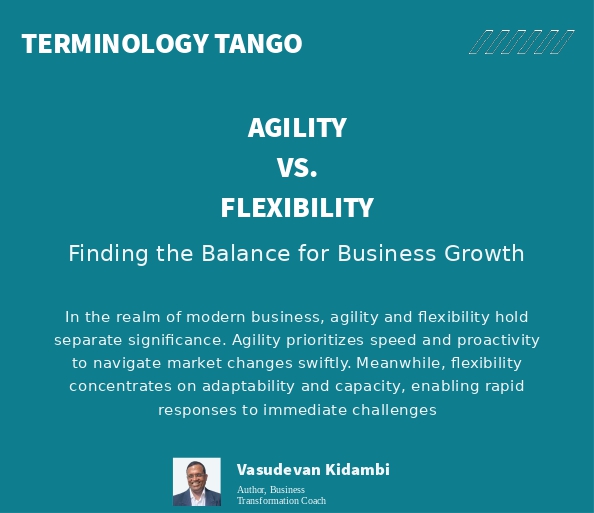Introduction
In the business world, terms like “agility” and “flexibility” are often used interchangeably, in the context of adaptability and responsiveness. However, these terms, while related, have distinct meanings and implications for organizations. Understanding the nuances can be a game-changer for corporate leaders aiming for sustainable success. This article aims to dissect the differences between agility and flexibility, providing clarity through real-world examples and use-cases.
What is Agility?
Agility refers to an organization’s ability to adapt quickly and effectively to market changes, both internally and externally, while maintaining continuous business operations. It involves being prepared for the unexpected and having the systems in place to deal with challenges efficiently. An agile organization or individual is like a well-trained athlete who can swiftly change direction without losing momentum.
Purpose
The primary purpose of agility is to respond to rapid changes in the market, customer preferences, or any other external factors. It’s about being proactive rather than reactive.
Scope
Agility encompasses various aspects of the business, from organizational structure to processes and culture. It often requires a company-wide commitment to adopt new methodologies, such as Agile frameworks.
Use Cases
Software Development: Agile methodologies enable quick iterations.
Supply Chain Management: Agile supply chains adapt to market fluctuations.
Marketing: Agile marketing strategies pivot based on real-time data.
What is Flexibility?
Flexibility is the capacity to bend, stretch, or adjust without breaking, the ability of an organization to adapt to changes as they occur. Unlike agility, flexibility is more about being reactive and able to change course when required. In a business context, flexibility might involve altering processes or strategies to accommodate new situations. Flexibility can be thought of as a key component of agility, allowing for smooth transitions between different states.
Purpose
The main aim of flexibility is to adapt to changes without causing disruptions in the workflow. It’s about having the capacity to change but not necessarily the speed.
Scope
Flexibility can be limited to specific departments or processes within an organization. It doesn’t always require a complete overhaul of business operations.
Use Cases
Remote Work: Flexibility to work from different locations.
Product Offerings: Ability to offer various products based on seasonal demand.
Customer Service: Flexible return policies to improve customer satisfaction.
Importance in Today’s Business Environment
In an era where change is the only constant, both agility and flexibility have become indispensable for businesses. The COVID-19 pandemic has further accelerated the need for these traits. Organizations that were agile could quickly pivot their strategies, while those that were flexible could adapt to new working conditions almost overnight. In a volatile market, being either agile or flexible is no longer an option but a necessity.
Challenges in Implementing
Implementing agility and flexibility is not without its challenges.
For agility, the hurdles often include resistance to change, lack of expertise in Agile methodologies, and the costs involved in transforming traditional systems.
For flexibility, challenges may include rigid organizational structures, lack of resources, and the potential for decreased productivity due to too much flexibility.
Key Differences

Real-World Examples
Agility
Amazon: Adapting its business model over time from an online bookstore to a global marketplace.
Netflix: Pivoting from DVD rentals to online streaming.
Flexibility
Toyota: Adapting production lines to produce ventilators during the COVID-19 pandemic.
Airbnb: Offering flexible booking options for travellers.
Conclusion
While both agility and flexibility are crucial for modern businesses, they serve different purposes and are applicable in various contexts. Agility is about speed and proactivity, aimed at staying ahead of market changes. Flexibility, on the other hand, is about capacity and adaptability, useful for reacting to immediate challenges. Understanding the unique strengths and applications of both can significantly impact your organization’s ability to succeed in today’s volatile business environment.
About the Author
Vasudevan Kidambi, a visionary leader and strategist, heads Navo Informatica Pvt. Ltd. and Navo Management Consultants, spearheading a paradigm shift in AI-enabled communication. With an illustrious career spanning three decades, Vasudevan embodies a fusion of innovation and transformation. He is also the 𝐚𝐮𝐭𝐡𝐨𝐫 𝐨𝐟 𝐀𝐦𝐚𝐳𝐨𝐧 #1 𝐁𝐞𝐬𝐭𝐬𝐞𝐥𝐥𝐞𝐫 𝐛𝐨𝐨𝐤 – 𝐎𝐧𝐞 𝐏𝐚𝐠𝐞 𝐂𝐨𝐦𝐦𝐮𝐧𝐢𝐜𝐚𝐭𝐨𝐫.
Known as the LAST-MILE MAN, Vasudevan’s distinctive approach combines human-centric problem-solving with cutting-edge technology. He has guided organizations through intricate challenges, consistently delivering effective solutions that drive significant change. His fervent passion for storytelling bridges traditional narratives with the digital age, harnessing AI’s power to amplify communication’s impact across content, images, and videos.
Beyond this, Vasudevan’s prowess in data analytics and data storytelling has earned him recognition as a dynamic influencer in reshaping corporate narratives. His strategic insights and analytical acumen have propelled businesses to leverage data-driven communication for informed decision-making.
Vasudevan’s influence reaches beyond corporate leadership. He’s a vocal advocate for integrating AI into business, dedicating over 300 hours to researching and implementing AI tools. Navo Informatica Pvt. Ltd, under his stewardship, is a trailblazer in AI-driven content, image, and video communication. The company wields AI to optimize communication strategies, engage customers, and spur growth.
A thought leader and influencer, Vasudevan educates professionals through webinars and boot camps focused on AI-enabled communication. His commitment to sharing insights, practical tips, and strategies underscores his belief that AI is a transformative force revolutionizing modern business. By empowering businesses to harness AI’s potential, Vasudevan propels them toward innovation, success, and sustained growth.


